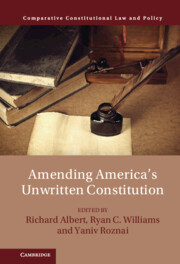Book contents
- Amending America’s Unwritten Constitution
- Comparative Constitutional Law and Policy
- Amending America’s Unwritten Constitution
- Copyright page
- Contents
- Contributors
- Acknowledgments
- Introduction A Return to Constitutional Basics: Amendment, Constitution, and Writtenness
- 1 The Unwritten Constitutions of the United States
- 2 Enumerating Amendments
- 3 Change Is the Only Constant: Unwritten Amendments and the Courts
- 4 The Role of the People in Unwritten Amendments
- 5 Unwritten State Constitutions? In Search of Constitutional Communities
- 6 State Constitutions and the Interaction between Formal Amendment and Unwritten Commitments
- 7 The Drive for a National Popular Vote for the Presidency: A Case Study in Amending the Unwritten Constitution
- 8 The Trump Presidency, the Racial Realignment, and the Future of Constitutional Norms
- 9 Amending an Unwritten Constitution: Comparative Perspectives
- 10 The Unwritten Foundations of (All) Written Constitutions
- Index
7 - The Drive for a National Popular Vote for the Presidency: A Case Study in Amending the Unwritten Constitution
Published online by Cambridge University Press: 13 October 2022
- Amending America’s Unwritten Constitution
- Comparative Constitutional Law and Policy
- Amending America’s Unwritten Constitution
- Copyright page
- Contents
- Contributors
- Acknowledgments
- Introduction A Return to Constitutional Basics: Amendment, Constitution, and Writtenness
- 1 The Unwritten Constitutions of the United States
- 2 Enumerating Amendments
- 3 Change Is the Only Constant: Unwritten Amendments and the Courts
- 4 The Role of the People in Unwritten Amendments
- 5 Unwritten State Constitutions? In Search of Constitutional Communities
- 6 State Constitutions and the Interaction between Formal Amendment and Unwritten Commitments
- 7 The Drive for a National Popular Vote for the Presidency: A Case Study in Amending the Unwritten Constitution
- 8 The Trump Presidency, the Racial Realignment, and the Future of Constitutional Norms
- 9 Amending an Unwritten Constitution: Comparative Perspectives
- 10 The Unwritten Foundations of (All) Written Constitutions
- Index
Summary
For present purposes, I take “America’s Unwritten Constitution” to refer (at least in some measure) to the norms, conventions, and practices that have developed in America to give meaning to, and fill in the gaps of, the constitutional text that was penned in 1787, ratified by a requisite number of states shortly thereafter, and formally amended by the Bill of Rights in 1791 and seventeen times during the two-and-a-quarter centuries since. One important constraint on the nation’s Unwritten Constitution is that is must, at some acceptable level, accommodate itself to the written document. A related feature of the Unwritten Constitution is that, as with the formal text, abiding aspects of the unwritten version need to be anchored in some kind of political foundation. These two features of the Unwritten Constitution – a fidelity to the document itself and a grounding in democratic processes – can be helpfully appreciated by examining another crucial component of today’s Unwritten Constitution, and one as to which federal courts have generally been much less central in determining the meaning and operation of the written Constitution’s provisions: the way we select Presidents in America.
Keywords
- Type
- Chapter
- Information
- Amending America's Unwritten Constitution , pp. 147 - 168Publisher: Cambridge University PressPrint publication year: 2022



